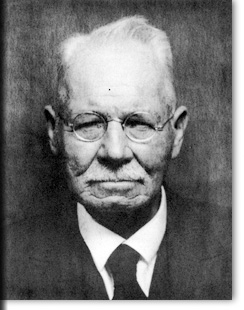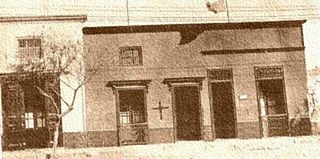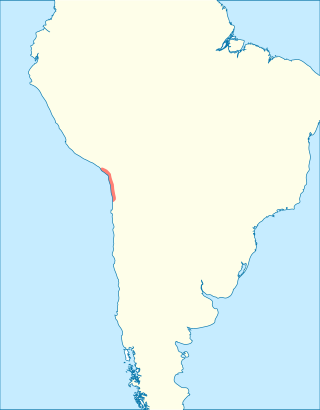This article's tone or style may not reflect the encyclopedic tone used on Wikipedia.(February 2020) |
Bernardo Arriaza is a Chilean physical anthropologist with an emphasis on bioarchaeology.
This article's tone or style may not reflect the encyclopedic tone used on Wikipedia.(February 2020) |
Bernardo Arriaza is a Chilean physical anthropologist with an emphasis on bioarchaeology.
Bernardo Arriaza was born in 1959 in Coltauco, Rancagua, Chile. He studied at the U de Norte, and later obtained a Bachelor's degree in Physical Anthropology. As an undergraduate, he was employed as an assistant to Late paleo-pathologist Marvin Allison and that is when Arriaza first became interested in the Chinchorro Culture. He later obtained a Master's and then Doctoral degrees in Physical Anthropology from Arizona State University.
Arriaza has more than 70 papers in scientific journals, he is the author of 10 books on the first populations of northern Chile, some with collaborators, including five of a scientific nature, two on scientific dissemination and three specialized catalogs. Three of these have been republished. He participated in 14 book chapters; he also has 50 scientific presentations at national and international scientific meetings. Has participated as a researcher in eight projects funded by FONDECYT, four as a principal investigator, and four as co-investigator. He has also participated in FONDART, NSF, FIC, and National Geographic Society grants, among others. He has been a scientific advisor on the Chinchorro Culture on 14 television documentaries including Discovery Channel and National Geographic.
In 1984 Arriaza wrote in the journal Chungara , his first work on the Chinchorro Culture in collaboration with other academics from the University of Tarapacá, ten years later, in 1994 he published in the Chungara a classification on the Chinchorro mummies, a typology that today is widely used by the scientific and general community. [1] A year later, in 1995 he wrote an important article [2] for National Geographic Magazine on the Chinchorro mummies, which was translated into several languages, including Japanese, French, and Portuguese. His work has helped to promote the Chinchorro mummies at the international level. The same year he wrote the book "Beyond Death: The Chinchorro Mummies of Ancient Chile [3] ". Smithsonian Institution Press. Washington, D.C. which was later translated, in 2003, into Spanish by Marlene Onate, Master of Art, University of Nevada Las Vegas, and published in Chile by the Universidad de Chile, prestigious Editorial Universitaria Press.
In 2002 with the collaboration of Vivien Standen, he wrote the book "Mummies, death and ancestral rites [4] ". University of Tarapacá. The work was published by the Editorial Universitaria Press in 2008. In 2005, he wrote his environmental hypothesis debating why the Chinchorro developed their artificial mummification practices, four years later, in 2009 he published with Vivien Standen "Catalogue Chinchorro Mummies". University of Tarapacá Press. In 2014 Arriaza published with Nuria Sanz and Vivien Standen "The Chinchorro Culture: A comparative perspective". The archaeology of the earliest human mummification. UNESCO, in 2016 he published with Vivien Standen "Chinchorro Culture: Past and Present". University of Tarapaca Press (In press). In 2016, he was nominated for the Chilean National History Award. [5] His last interviews were by the Chilean Magazine "Qué Pasa [6] " and by the newspaper "Diario Uchile [7] " but he's been consulted and cited since 1994 [8]
Arriaza's involvement with the community began in 2005 with the project explore program: "Understand the desert so that we are players in the development of our region", an activity held in conjunction with Arica high schools. A year before, in 2004, he was involved in the creation of the website www.momiaschinchorro.com, subsequently transformed to chinchorro.cl (currently in redesign). In 2008, he was part of the publishing of the cartoon"Arqueonautas: The Chinchorro Vol. 1". Financed by GORE of Arica (distributed to schools), also in 2008 he participated as main scientific advisor in the documentary "Chinchorro: 3,000 years before King Tut" [9] by Herman Mondaca Raitieri Danús and Andrés Vargas. In 2009, he won the FONDART grant on teaching materials on Chinchorro which was delivered to schools in the region of Arica and Parinacota.
• 1999, Barrick Award Scholar Award from the University of Nevada, United States.
• 1999, Medal of Professional Merit by the Municipality of Arica.
• 2004, Lifetime Achievement Award from the Municipality of Coltauco, VI Region.
• 2013, Outstanding researcher, University of Tarapacá.
• 2015, Honor, declared "Ambassador of the Chinchorro Culture". Distinction awarded by the University of Tarapacá and the Municipality of Camarones. [10]

A mummy is a dead human or an animal whose soft tissues and organs have been preserved by either intentional or accidental exposure to chemicals, extreme cold, very low humidity, or lack of air, so that the recovered body does not decay further if kept in cool and dry conditions. Some authorities restrict the use of the term to bodies deliberately embalmed with chemicals, but the use of the word to cover accidentally desiccated bodies goes back to at least the early 17th century.

The Huilliche, Huiliche or Huilliche-Mapuche are the southern partiality of the Mapuche macroethnic group in Chile and Argentina. Located in the Zona Sur, they inhabit both Futahuillimapu and, as the Cunco or Veliche subgroup, the northern half of Chiloé Island. The Huilliche are the principal indigenous people of those regions. According to Ricardo E. Latcham the term Huilliche started to be used in Spanish after the second founding of Valdivia in 1645, adopting the usage of the Mapuches of Araucanía for the southern Mapuche tribes. Huilliche means 'southerners' A genetic study showed significant affinities between Huilliches and indigenous peoples east of the Andes, which suggests but does not prove a partial origin in present-day Argentina.
University of Tarapacá is a university in Arica, Chile. It is a derivative university part of the Chilean Traditional Universities. The university publishes Revista Chungará a journal on anthropology and archaeology.
Azapa Valley is a fertile and narrow oasis in Arica y Parinacota Region, Chile. It is framed between two arid hills and divided by the San Jose River that runs during the summer season. It is located three kilometres (1.9 mi) from the city of Arica. This jewel of the north has a unique climate that permits the farming of a great variety of fruits and vegetables throughout the year. This is in addition to the unique Azapa olives, renowned for their violet color and bitter flavor that also yield a hearty oil.

The Chinchorro mummies are mummified remains of individuals from the South American Chinchorro culture, found in what is now northern Chile. They are the oldest examples of artificially mummified human remains, having been buried up to two thousand years before the Egyptian mummies. The earliest mummy that has been found in Egypt dates from around 3000 BCE, while the oldest purposefully artificially preserved Chinchorro mummy dates from around 5050 BCE.

Friedrich Max Uhle was a German archaeologist, whose work in Peru, Chile, Ecuador and Bolivia at the turn of the Twentieth Century had a significant impact on the practice of archaeology of South America.
Laguna de las Momias, also known as Laguna de los Cóndores is an archaeological site located in Leimebamba, Chachapoyas province, in the Amazonas Region of Peru, excavated by the archaeologist Federico Kauffmann Doig. The site is called Lagoon of the Condors because the people who found the lagoon would see these birds soar near the lagoon; it also obtained the name Lagoon of the Mummies because of the mummy findings around the area. The Chachapoyas were an old civilization that was located in the northern forest in the time of 900 a.c. This culture had been unknown by archaeologists for hundreds of years until the mummies appeared.

Tarapacá is a town and municipality in the Colombian Department of Amazonas. As of 2015, the population comprised 4,195 people.

Museo de la Naturaleza y Arqueología (MUNA), is a museum-based in Santa Cruz de Tenerife, Tenerife,. It contains many significant archaeological finds and is considered the best repository of objects from the Pre-Castilian Canary Islands. The museum also houses significant paleontological, botanical, entomological, and marine and terrestrial vertebrate collections, and is considered the best Natural Library of the Canary Islands.

The precolonial history of Chile refers to the period from the first human populations in the territory of Chile until the first European exploration of the region, by Spaniard Diego de Almagro in 1535–36.
Chungara Revista de Antropología Chilena is a peer-reviewed academic journal on anthropology and archaeology with particular, but not exclusive, focus on the Andean region. The journal is published by the Departamento de Antropología and the editor-in-chief is Vivien G. Standen.

The Chilenization of Tacna, Arica, and Tarapacá was a process of forced transculturation or acculturation in the areas which were invaded and incorporated by Chile since the War of the Pacific (1879–1883). The aim of the Chilenization was to create a dominance of Chilean traditions and culture in that region, in preference to those of the Peruvian population. The British desire to reunite all saltpeter mines under one political administration was also a major factor that influenced the outcome of the war.

The Patriotic Leagues were nationalistic political groups in Argentina and Chile active from the 1910s to the 1930s. The Patriotic Leagues were characterized by actions against foreigners and opposition towards labour movements. They were often constituted as paramilitary groups or secret societies.
Alicia Galaz Vivar was a Chilean poet and literary researcher. She was the founder and director of the poetry magazine Tebaida.

The Chiribaya culture flourished near the coast of southern Peru and adjacent Chile from 700 CE until Spanish settlement in the late 16th century. The classic phase of the Chiribaya culture was from 1000 CE until 1360 CE. The Chiribaya culture consisted of both maritime settlements along 220 kilometres (140 mi) of the Pacific Ocean coast and agricultural settlements inland in valleys of the Osmore and Tambo rivers in Peru and the Lluta river and Azapa Valley in Chile.

The Chinchorro culture of South America was a preceramic culture that lasted from 9,100 to 3,500 years BP. The people forming the Chinchorro culture were sedentary fishermen inhabiting the Pacific coastal region of current northern Chile and southern Peru. Presence of fresh water in the arid region on the coast facilitated human settlement in this area. The Chinchorro were famous for their detailed mummification and funerary practices. The area of the Chinchorro culture started to receive influences from the Andean Plateau around 4,000 BP, which led to the adoption of agriculture. Much later, it came under the influence of the Tiwanaku Empire.

Chirodactylus variegatus, the Peruvian morwong or bilagai, is a species of marine ray-finned fish traditionally regarded as belonging to the family Cheilodactylidae, the members of which are commonly known as morwongs. It is found in the southeastern Pacific Ocean off the western coast of South America.
El Molle culture was a South American archaeological culture from in the Transverse Valleys of Norte Chico known chiefly for its ceramics. The culture existed from 300 to 700 CE and was later replaced in Chile by Las Ánimas culture that developed between 800 and 1000 CE. This last culture then gave way to the historical Diaguita culture encountered by the Spanish in the 16th century. El Molle culture coexisted for a significant time with La Animas culture. It is possible that Las Ánimas culture learned copper metallurgy from El Molle.
Chiapa is a Chilean town. Chiapa is a town located in the Tarapacá Region, Tamarugal Province, Huara Commune, Chile. It is located in the area of the Precordillera, about 3,200 meters above sea level. Its inhabitants are mainly Aymara descendants, with lineages that identify themselves as Quechua origin. However, according to the anthropological evidence existing to date, there were no Quechua-speaking communities at the time of the Spanish colonization in the Chiapa Valley or in the Quebrada de Aroma, without prejudice to the probable existence of multi-ethnic lineages.